|
Porsche - Origin of the Species
Price: $189.95
|
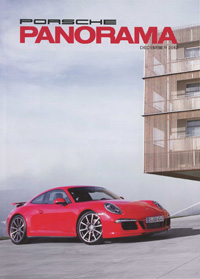
Porsche Panorama Magazine - December 2012
The Private Live of 356-001
An excerpt from Karl Ludvigsen's Porsche - Origin of the Species tells the story of the first car to bear the name Porsche
The 356 roadster officially came to rest in Switzerland. Its first owner after Porsche was the Riesbach garage in Zürich. The garage's owner Josh Heintz bought the Porsche for 7,000 Swiss francs-about $1,750-in September of 1948; an Austrian export license was granted on September 7. The Riesbach garage put the Number One Porsche in its new-car showroom for sale. Though the 356 was admired by many onlookers, no one had the courage to buy this unknown vehicle. A friend of the garage owner, Peter Kaiser, was willing to take the car for 7,500 francs-more or less as a favor to Heintz.
Not until December 20 was the car officially registered for the road in Switzerland, where it bore the plate number ZH20 460. The porsche lettering on the car's front deck didn't meet with Kaiser's enthusiasm. "I wasn't interested in advertising Porsche," he said, "so I changed the name." He felt that it didn't fit well with other sports cars, which had sonorous, zippy names like Alfa Romeo and Jaguar. Thus he rearranged the original lettering to spell PESCO.
The car became Kaiser's daily driver. "I had the feeling of driving a very lively and agile automobile," he said. "I had to park it in the darkest back streets of Zürich, because otherwise there would be a huge crowd of people around it when I returned. They didn't know which end was the front and which the back."
In the spring of 1949 Kaiser sent the car to Metsch, a friend in Frankental in Germany, to have its brakes converted from cable to hydraulic operation. In 1951, after Porsche set up in business in Stuttgart, he took the roadster to the works, only to be told that they had no interest in it. This "failed design" was nothing to do with them, they said.
In 1951 Peter Kaiser sold the 356 to Zürich VW importer AMAG for 4,500 francs. At the time, said Kaiser, its seats were uncomfortable, body seams were opening up, the doors were dropping after the hinges went, the seating between the frame trusses was narrow, the engine was weakening and the suspension springing was suffering. "It was falling to bits," he recalled.
Shortly thereafter Rosemarie Muff of Zurich acquired the Porsche for no less than 10,000 francs. After she had driven the car into the ground, swanning slowly about the streets of Zürich, Hermann Schulthess bought it for 3,000 francs, still in 1951. Now the first Porsche felt that it was finally in good hands. Zürich's Schulthess, a car hobbyist, rebuilt the 356 completely, restoring its "Porsche" badging.
On a trip over the Gotthard Pass the Porsche nearly collided with a goat. Avoiding it, Schulthess braked so severely that the Opel following him, occupied by six nuns from the Einsiedeln nunnery, ran into him and pushed the 356 into the car in front. Both ends were significantly damaged and had to be repaired in the bodywork department of AMAG in Zürich. On this occasion the front and rear were altered and aligned more with the design of contemporary production Porsches.
In 1952 Hermann Schulthess took the car to the Porsche factory for the installation of larger hydraulic brakes and a 1500S engine. The only person in the works who expressed pleasure at this reunion with "our first Porsche," as he called it, was business chief Leopold Prinzing. Otherwise no one took a particular interest in it.
With its strong engine and great brakes, thought Hermann Schulthess, the car was certainly race-ready. But the only actual race that 356 Number One entered was the Swiss Mitholz-Kandersteg Hill Climb in 1953. Mark Engler from Ascona drove it to second place behind winner Hans Stanek in his Porsche-powered Glöckler special. That year the car also participated in several Swiss rallies.
The next owner was Zürich master baker Igoris. It was love at first sight when he saw the 356 being inspected at AMAG. Igoris exchanged his Porsche 356 1300 coupe for the car with Hermann Schulthess. Although he wanted to renege on the deal the next day because Number One didn't meet his expectations, Schulthess refused. From then on the car stood in the garage of Igoris and deteriorated.
The last private owner of Porsche No. 1 was Franz Blaser of Laachen on the Zürich Obersee. On one of his daily trips to Zürich the auto mechanic spotted the car sitting in the Igoris garage and bought it. Again the car was completely overhauled and restored and returned to the road.
In 1958, celebrating its first decade, the Porsche factory in Zuffenhausen decided to retrieve the first car bearing the Porsche name. The intention was to set up an exhibit at the factory in which all previous Porsche designs would be assembled and admired. Porsche's Richard von Frankenberg, a friend of Hermann Schult-hess, assumed that he was still in possession of No. 1 and asked if he would sell the car. Frankenberg was referred to Blaser, who happily exchanged his roadster against a factory-new Porsche Speedster.
Thereafter the 356 has been in the Porsche collection. Around 1975 it was restored to an approximation of its original appearance. In many respects however it remains substantially modified from its original setup.
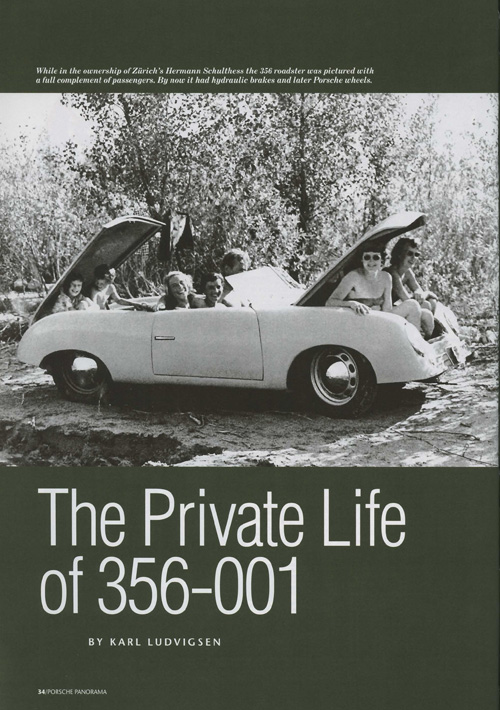
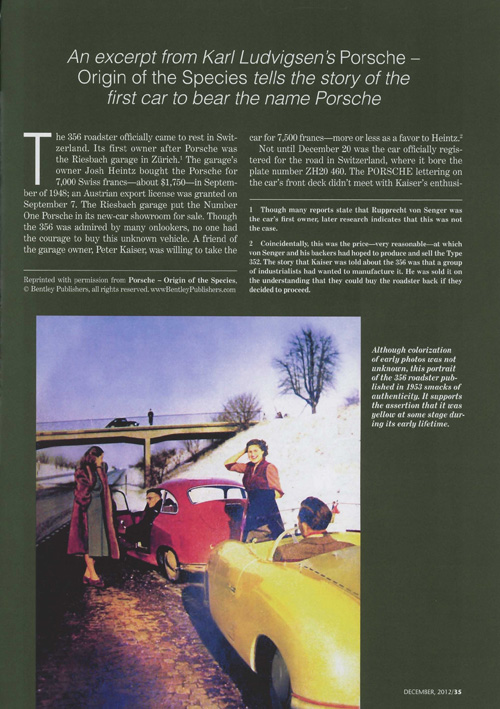
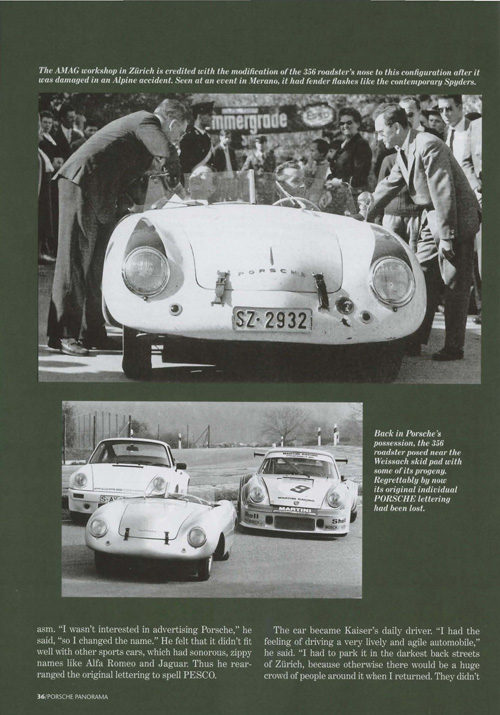
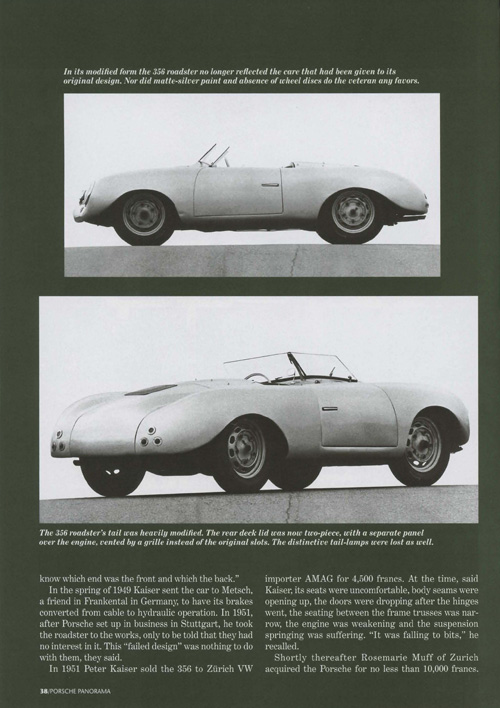
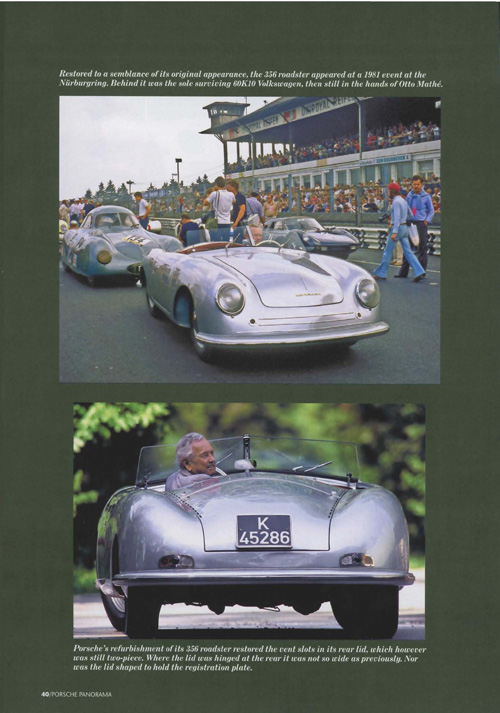
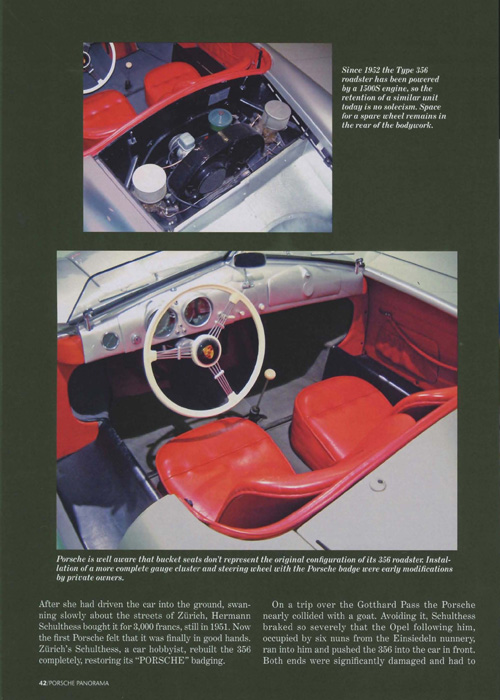
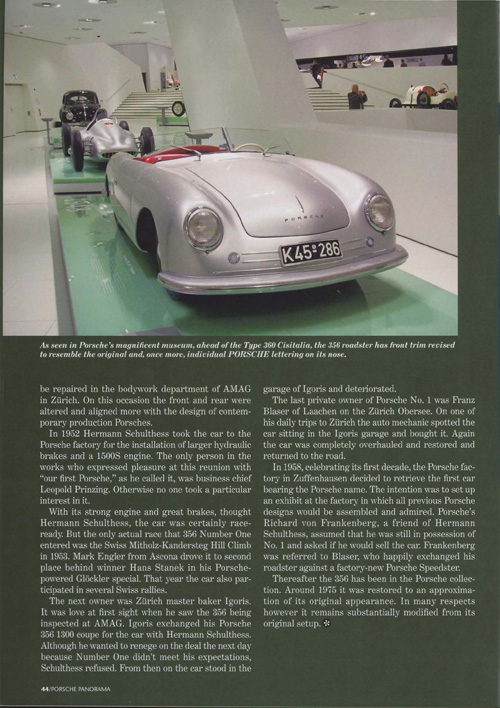
Article from and courtesy of Porsche Panorama Magazine - December 2012
![[B] Bentley Publishers](http://assets1.bentleypublishers.com/images/bentley-logos/bp-banner-234x60-bookblue.jpg)

